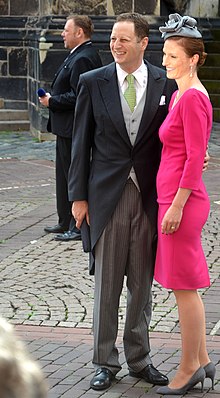Cutaway

The cutaway , also cut ( pronunciation : [ kœt ], also [ kat ]), is a formal garment for men developed from the frock coat , which was established in its current form around 1900 in England. The origins go back to the time after 1850.
classification
The cutaway is the great formal suit of the day . This differentiates it from the evening dress suit , the tailcoat , and the day dress suit , the Stresemann and the evening dress suit , the tuxedo .
The English name morning coat makes it the counterpart of the tail coat ( white tie or tail coat ). The cut is the most festive morning suit according to western protocol, it can be replaced by the less festive Stresemann. Like the Stresemann, it is primarily worn in the morning and in any case no later than 6 p.m. As the most festive day suit, it is worn at weddings, high-class funerals or state receptions. For example, ambassadors wear it when handing over the credentials to the head of state in the receiving state. Although the cut, like the tailcoat, was originally a bourgeois clothing (the nobility usually wore a uniform at festivals and ceremonial occasions ), today it is often worn on the European continent at aristocratic weddings.
The term "cutaway" is derived from the cut away corners of the frock coat.
description
The cutaway consists of a gray or black jacket, black and gray striped (Stresemann) trousers , black shoes , a light gray or colored vest (in the case of a burial, it should be made of the same dark fabric as the jacket ) and a white shirt . The tie for the cutaway is traditionally silver-gray , but more recently colored ties have also become common. The tie is definitely black for funeral services. A plastron can also be worn instead of a tie . The cut is a frock coat with a round shoulder . The classic cut includes ankle-length white woolen gaiters with a web, which have a fluffy inside.
In the light gray cut - often worn at horse races (see Royal Ascot ) - the vest and trousers are often made of the same fabric as the jacket. Traditionally, a black or silver-gray cylinder and a white chrysanthemum in the buttonhole are still worn today . A bow tie , belt or cummerbund is never worn with the cutaway .
literature
- Ingrid Loschek : Reclams Mode and Costume Lexicon , Verlag Philipp Reclam jun., Stuttgart 2005, ISBN 3-15-010577-3 .
- Michael F. Feldkamp : Tailcoat and cut in the Bundestag . The introduction of the Bundestag tailcoat 50 years ago . In: ZParl 37 (2006), pp. 481-492.
- Michael F. Feldkamp: The House. Protocol and ceremonial in the German Bundestag , in: Show the flag? The Germans and their national symbols. Book accompanying the exhibition in the House of History of the Federal Republic of Germany. Kerber, Leipzig 2008, pp. 99-103, ISBN 978-3-86678-224-2 .
- Enrico Brissa: On the floor. Little manual of worldly conduct. Siedler Verlag, Munich 2018 ISBN 978-3-8275-0112-7